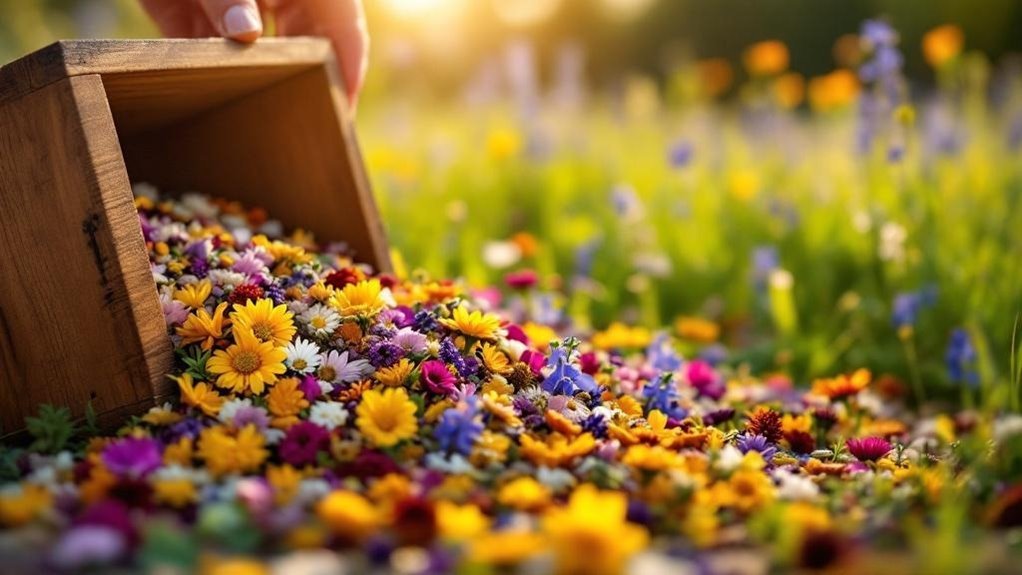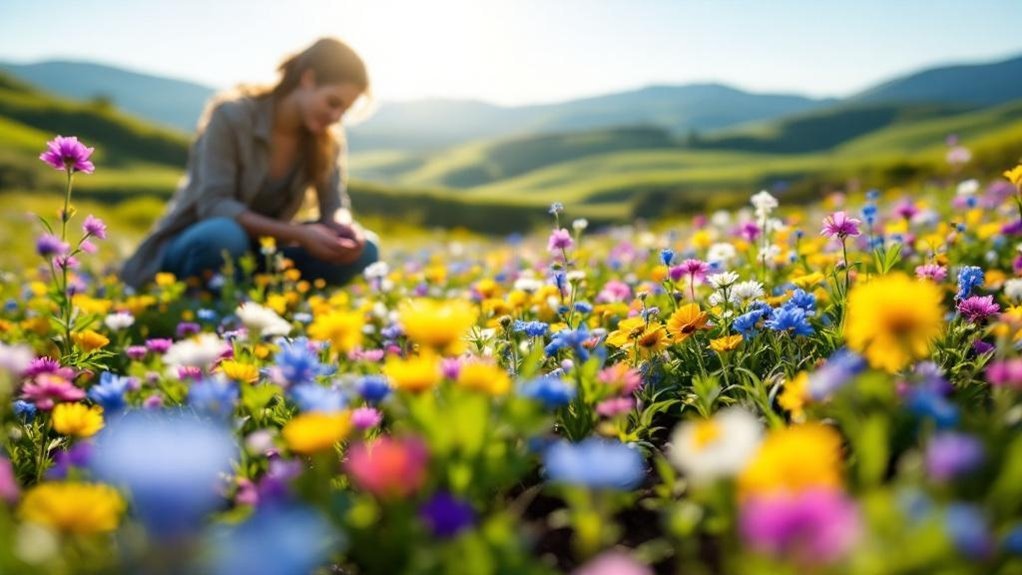You might think planting a wildflower meadow is as simple as scattering seeds and waiting, but it’s far more involved than that. If you want a meadow that truly thrives, you’ll need to take into account everything from site selection to seed mix and timing. The good news is, with the right approach, you can create a stunning, sustainable landscape. Let’s start by looking at how to choose the perfect spot for your meadow.
Choosing the Right Site for Your Meadow
When choosing the right site for your wildflower meadow, you’ll want to guarantee it gets at least six hours of full sun daily to support diverse species.
Look for well-drained soil, as many native wildflowers prefer it; if drainage is poor, adjust your species selection accordingly.
Make sure the area experiences minimal disturbance and avoid pesticide exposure to encourage pollinator activity.
Assess existing vegetation and soil conditions carefully—these factors reveal the site’s suitability and help guide what wildflowers will thrive.
Also, provide adequate space; a minimum of 400 square feet is recommended to allow wildflowers room to grow and pollinators to flourish.
Preparing the Soil and Site for Planting
Selecting the perfect site sets the stage, but preparing the soil and area properly guarantees your wildflower seeds take root and flourish.
Start by clearing existing vegetation carefully—avoid tilling to prevent bringing weed seeds to the surface. Use solarization by covering the soil with clear plastic for 4-6 weeks to kill grasses and weeds. Incorporate cover crops like buckwheat or clover during site preparation to suppress weeds and enrich the soil naturally.
Make certain your chosen spot receives adequate sunlight—at least six hours daily—and has good drainage to support diverse wildflower species. Focus on achieving solid seed-to-soil contact; this step is vital for germination.
Selecting and Mixing Wildflower Seeds

Although choosing wildflower seeds might seem straightforward, focusing on native species adapted to your local climate and soil will greatly boost your meadow’s success.
Selecting a diverse mix that balances wildflowers with native grasses (50-80%) helps reduce weed competition and supports beneficial insects, enhancing ecosystem resilience.
Pay close attention to bloom times by including annuals, biennials, and perennials to maintain continuous color.
Tailor your wildflower mix to site microhabitats—like wet or shaded areas—to match soil conditions and maximize growth.
Avoid noxious weeds by researching seed sources carefully.
Consider these key points when selecting and mixing wildflower seeds:
- Prioritize native species suited to your region
- Include a diverse mix for seasonal bloom variation
- Balance wildflowers with native grasses
- Match seeds to site microhabitats
- Exclude invasive or noxious plants
Planting Techniques and Timing
Since wildflower seeds require specific conditions to thrive, timing your planting is crucial for success. The ideal time for planting wildflower seeds is fall planting, especially from late September to early December, when soil temperature supports better germination.
To guarantee even distribution, mix seeds with sand or vermiculite at an 8:1 ratio before you broadcast seeds in two directions—north-south, then east-west. This technique prevents overcrowding and promotes healthy growth of meadow species.
After sowing, improve seed-to-soil contact by lightly raking or rolling the soil, which helps retain moisture. Finally, cover the area with a thin layer of straw mulch to secure the seeds and protect tiny seeds that need light for germination. Following these steps boosts your meadow’s chances of thriving.
Managing Growth and Early Maintenance

While your wildflower meadow starts to take root, you’ll need to keep a close eye on weed growth and water the seedlings consistently until they reach about 6 to 8 inches tall.
Effective monitoring during this early establishment phase helps prevent weeds and invasive species from outcompeting your wildflower seedlings. Supplemental watering is key, especially during dry spells, to support healthy growth in your soil.
Mowing at 4 to 6 inches can control weeds without damaging young plants. Focus your maintenance on these tasks to encourage a thriving meadow.
- Monitor regularly for weeds and invasive species
- Water seedlings consistently until 6-8 inches tall
- Provide supplemental watering during dry periods
- Mow carefully to manage weeds without harming seedlings
- Adjust maintenance as wildflowers establish and grow
Long-Term Care and Meadow Development
As your wildflower meadow matures, you’ll find that it needs far less hands-on care, shifting your focus to monitoring aggressive weeds and occasional mowing to maintain its health and biodiversity.
Long-term meadow management involves regular assessments of soil health and moisture to support native species growth. Controlled burns or timely mowing help control invasive species and guide ecological succession, promoting a balanced ecosystem.
Over time, reseeding with diverse wildflower mixes or transplanting native plants can fill bare spots and boost species diversity.
By practicing minimal maintenance and staying vigilant against aggressive weeds, you guarantee your meadow flourishes year after year, showcasing vibrant blooms and a thriving habitat.
This approach sustains both the beauty and ecological function of your wildflower meadow over the long term.
Frequently Asked Questions
Can I Just Throw Wildflower Seeds on the Ground?
You can’t just throw wildflower seeds on the ground and expect success. You’ll need to prepare the soil, control weeds, and guarantee good seed-to-soil contact to help your wildflowers germinate and thrive properly.
What Is the Best Month to Plant Wildflowers?
You should plant wildflower seeds in mid- to late-October. This timing allows for natural cold stratification, improving germination. Avoid November’s unpredictable weather, and prepare a clean seedbed before sowing for the best results.
What Are the Disadvantages of a Wildflower Meadow?
Wildflower meadows can be like waiting for paint to dry—you’ll need patience as they take years to establish. You’ll also wrestle with weeds, inconsistent blooms, and extra watering, especially during the first year’s growth.
Should I Soak My Wildflower Seeds Before Planting?
You generally don’t need to soak wildflower seeds before planting since they germinate better dry. Only soak hard-coated seeds for a few hours if recommended, but avoid over-soaking to prevent rot and poor germination.
Final Thoughts
Creating your wildflower meadow isn’t just about pretty blooms—it’s about fostering a balanced ecosystem. Some say wildflowers grow best naturally, but careful site choice, soil prep, and seed selection actually make a huge difference. By planting thoughtfully and maintaining your meadow early on, you’ll encourage diverse growth and resilience. With patience and dedication, your meadow will flourish, proving that a little planning truly transforms nature’s beauty into a sustainable, vibrant habitat.
